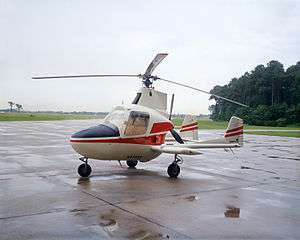Drago Jovanovich
D. K. (Dragoljub Kosta) or "Gish" Jovanovich (January 24, 1916 – November 12, 1983) was born in Yugoslavia (pre-Communist Kingdom of Yugoslavia). He lived in Philadelphia and later settled in Southern California. He was a Serbian-American helicopter designer, inventor, and pioneer in autogyro technology.

Piasecki and HERC
Jovanovich and Frank Kozloski founded the Helicopter Engineering Research Corporation (HERC) in Philadelphia, Pennsylvania in 1946. HERC was the predecessor of Jovair. Jovanovich and Kozloski previously worked for Piasecki Helicopter Corporation where Jovanovich's patented tandem rotary design was used on the Piasecki PV-3.[1]
The first helicopter they designed was the HERC JOV-3. This was first flown in 1948.[2] They used the Boulevard Airport (formerly William Penn Airport) as their base.[3]
McCulloch
In 1949 Jovanovich and Kozloski transferred to the McCulloch Aircraft Corporation, the new helicopter and aircraft division of McCulloch Motors Corporation. The design principles of the JOV-3 were incorporated into the McCulloch MC-4, which first flew in March 1951.[4] In 1952, the MC-4C, a modified MC-4, was acquired by the US Army in 1952 for testing, but was deemed underpowered and none were further ordered.
Hughes
In 1955 Jovanovich designed a rotor for Howard Hughes' Hughes 269.[5] This was followed by hub blades for the three-blade light helicopter, the 1958 Del Mar DH-1 Whirlymite series, and the hub for the Hughes 500.
Jovair

In 1960 Jovanovich formed Jovair Corporation to continue development of the MC-4. A new version the Jovair Sedan 4E called the Jovairin was type approved by the FAA in March 1963. The billionaire, Bill Lear, tried to spark interest in its production without success.[6]
With McCulloch Corporation funding, Jovanovich designed and developed an autogyro, the McCulloch J-2, that could take off from a residential driveway. Jovanovich had patented a similar concept in 1954.[7] Development was slow because Jovair lacked staff and resources yet the first prototype flew in 1962. Flying Magazine's review of the J-2 was unflattering to both Jovanovich and the J-2.[8] A retraction of the comments about Jovanovich was published three months later.[9]
Aircraft designed by Jovanovich
- The tandem rotary on the Piasecki PV-3
- HERC JOV-3
- McCulloch MC-4[10]
- The rotor blades on the Hughes 269
- Jovair Sedan 4E
- McCulloch J-2[11]
Patents
- Helicopter #USD168794 S (Publication Date: 1953)
- Means for connecting rotor blades to rotor bodies #US2672941 A (Publication Date: 1954)
- Damping means for blades of aircraft sustaining rotors #US 2696271 A (Publication Date: 1954)
- Rotor blade for helicopters #US 2712356 A (Publication Date: 1955)
- Pitch control means for aircraft sustaining rotors #US 2753004 A(Publication Date: 1956)
- Movement limiting means for blades of aircraft sustaining rotors #US 2742098 A (Publication Date: 1956)
- Helicopter Control Mechanism #US2856788 A (Publication Date: 1958)
- Convertiplane #US 2852207 A (Publication Date: 1958)
- Helicopter rotor blade #US2941603 A (Publication Date: 1960)
- Blade-to-hub connector for thrust producing rotor #US 2949967 A (Publication Date: 1960)
- Helicopter #US D191929 S (Publication Date: 1961)
See also
References
- ↑ Introduction: A history of helicopter flight, J. Gordon Leishman, Principles of Helicopter Aerodynamics, Cambridge Aerospace Series, Edition 2, Cambridge University Press, 2006, ISBN 0521858607, 9780521858601
- ↑ McCulloch YH-30 MC-4C, Harold A. Skaarup, Alabama Warbird Survivors 2003: A Handbook on Where to Find Them, Writers Club Press, 2002, ISBN 0595652034, pages 98-100
- ↑ http://www.airfields-freeman.com/PA/Airfields_PA_Philly_NE.htm
- ↑ The Flying Windmills will truck an army, Herbert O Johansen, Popular Science, July 1951, page 92
- ↑ McDonnell Douglas Aircraft Since 1920, Volume 2 of Putnam Aviation Series, René J.Francillon, Putnam Aeronautical Books, Naval Institute Press, 1990, page 26, ISBN 1557505500, 978155750550
- ↑ Basic Guide to Flying, Paul Fillingham, Penguin Group (USA) Incorporated, 1985, ISBN 0801505267, 9780801505263, page 291
- ↑ http://www.google.com/patents/US2852207
- ↑ Everybody loves and autogyro, Flying Magazine February 1971, pages 67-68
- ↑ A correction, Flying Magazine, May 1971, page 6
- ↑ The Flying Windmills will truck an army, Herbert O Johansen, Popular Science, July 1951, page 92
- ↑ "Aeronautics: Return of the Autogiro". Time. March 29, 1968. Retrieved 30 May 2010.